Advertisements
Advertisements
प्रश्न
What are the three components of population change?
उत्तर
- Crude Birth Rate (CBR): It is expressed as number of live births in a year per thousand of population in a particular region.
- Crude Death Rate (CDR): It is the number of deaths in a place per thousand of population in a particular region. CBR and CDR are natural factors of population growth. They result in natural population growth, which is equal to the difference between CBR and CDR.
- Migration: It is the induced factor in population growth. It is the number of people moving in and out of a place due to various social, economic and political reasons. It is taken into account while calculating actual growth of population.
APPEARS IN
संबंधित प्रश्न
List any three important characteristics of a population and explain.
If the birth rate is greater than the death rate then the population ______.
Examine the following statement and correct the incorrect one.
Greater economic prosperity indicates the development of a region.
Examine the following statement and correct the incorrect one.
Developing countries have an HDI of 1.
Give Geographical Reason.
The real progress of a country is understood with the help of the Human Development Index.
Identify the correct correlation :
A: Assertion; R: Reasoning
A: Population of a region does not change.
R: Birth rate, death rate, and migration affect the population of a region.
Write a short note on the correlation between birth rates and death rates.
Give a geographical reason:
Population may increase though birth rates are low.
Assertion: Population of a region does not change.
Reason: Birth rate, death rate and migration affect the population of a region.
India’s population as per 2011 census is:
Which one of the following is not a push factor?
Birth rate and death rate.
What is population doubling time?
What is the impact of migration?
What is population growth? What does population change indicate for an area?
How did science and technology help in population growth?
Define the term ‘positive growth of population’.
How many stages/phases of population growth?
What was the population of India as per the 2011 Census?
In how many years India's population will be doubled?
Which one of the following is not a component of population change?
How many times the world population has increased during the last 500 years?
What is the present growth rate of population in the world?
Which of the following is not a push factor for migration?
Which are the components of population change?
Consider the following statements and choose the correct option from the given options:
1. Population grown rapidly during the sixteenth and seventeenth centuries.
2. Expansion of world trade during the sixteenth and seventeenth centuries is an important cause of it.
Study the given graph carefully and answer the following question:
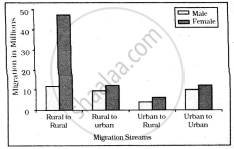
Intra-state Migration by place of Last Residence Indicating Migration Streams India, 2011
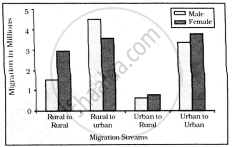
Inter-state Migration by Place of Last Residence Indicating Migration Streams India, 2011
Who dominates the inter-state migration of short distances?
The number of mice in a laboratory was 100 on a particular day. After one year their number increased to 120. Calculate the growth rate in the population.
On the basis of the demographic data of a country given below, construct an age pyramid and explain whether the population is stable, declining or growing.
| Age group | No. of individuals |
| Pre-reproductive | 20,000 |
| Reproductive | 15,000 |
| Post-reproductive | 10,000 |
The term Crude Birth Rate (CBR) is closest to which of the following?
Which of these is a major cause of female migration in India?
Which of the following pairs is not correctly matched?
Which of the following formula correctly depicts natural growth of population?
Which of the following forms the component of a nation?
What would be the per cent growth or birth rate per individual per hour for the same population mentioned in the previous question (Question 10)?
In 2005, for each of the 14 million people present in a country, 0.028 were born and 0.008 died during the year. Using exponential equation, the number of people present in 2015 is predicted as ______.
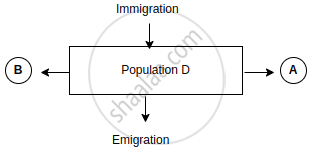
Observe the schematic representation given above and answer the following questions:
- Identify A and B.
- Calculate the growth rate of bacteria in a curd sample, where 1 million bacteria increased to two million, within a period of one hour.
Analyse the main features of Phase-III (1951 - 81) of growth of population in India.
Assertion (A): Population of a region does not change.
Reasoning (R): Birth rate, death rate and migration affect the population of a region.
A: Population of a region does not change.
R: Birth rate, death rate and migration affect the population of a region.
Assertion (A): Population of a region does not change.
Reason (R): Birth rate, death rate and migration affect the population of a region.
A: The population of a region does not change.
R: Birth rate, death rate and migration affect the population of a region.
A: Assertion; R: Reasoning
A: The population of a region does not change.
R: Birth rate, death rate and migration affect the population of a region.
Assertion (A): Population of a region does not change.
Reasoning (R): Birth rate, death rate and migration affect the population of a region.
Assertion: Population of a region does not change.
Reason: Birth rate, death rate and migration affect the population of a region.
Study the two figures shown below that represent two growth models.
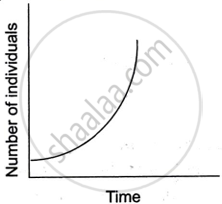 |
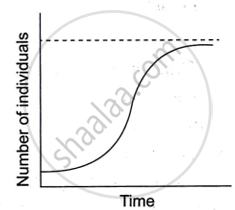 |
| Figure A | Figure B |
- Which one of the two figures represents an unlimited supply of nutrients? Give a reason.
- Which figure depicts a challenge to population growth?
- Explain the term reproductive fitness.
- Give the mathematical expressions for Figure A and Figure B.
Assertion (A): Population of a region does not change.
Reasoning (R): Birth rate, death rate and migration affect the population of a region.
Assertion : Population of a region does not change.
Reasoning : Birth rate, death rate and migration affect the population of a region.
Define the following term:
Growth rate of population
Assertion (A): Population of a region does not change.
Reasoning (R): Birth rate, death rate and migration affect the population of a region.
